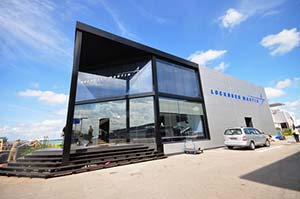 What if the F-35 is cancelled?
What if the F-35 is cancelled?
That's a question that has no doubt been on the mind of every holder or prospective buyer of Lockheed Martin Corp. (NYSE: LMT) stock.
The F-35 is the largest military contract in history. Lockheed serves as the principal contractor - with some help from Northrop Grumman Corp. (NYSE: NOC) and BAE Systems Plc. (OTCMKTS ADR: BAESY) on fuselage parts - on the ambitious Joint Strike Fighter program that is expected to cost $1.4 trillion over the 56-year life cycle of the project.
Of that $1.4 trillion, $1 trillion will go toward maintaining the aircraft and another $400 billion will go toward the actual purchases of over 3,000 planes - 2,400 in the United States and 600 spread across foreign buyers in the UK, Australia, Canada, Denmark, Italy, the Netherlands, Norway, and Turkey.
There are also buyers in Israel, Japan, and South Korea, with some rumblings that Singapore will join the buying frenzy as well.
What makes this project so ambitious is that it is the next generation of manned fighter craft and is by many expectations going to be the last manned jet. Unlike past fighter craft like the F-15 used by the Air Force or the F-18 used by the Navy and Marine Corps - both Boeing Co. (NYSE: BA) aircrafts - the F-35 serves many masters.
It's going to be purchased by the U.S. Air Force, the U.S. Navy, the U.S. Marine Corps, as well as the UK Royal Air Force and the Royal Navy.
All in all, it's a giant military contract. The stakes are high for Lockheed Martin - and LMT stock - to deliver on this program. Investors are nervous.
And no one can blame them.
The F-22 ended up being scrapped after ten years in 2009, when the costs and delays became too fiscally untenable for Congress to continue funding.
In fact, Lockheed Martin's history has been colored by failed projects...
Lockheed Martin (NYSE: LMT) Stock Facing History of Unsuccessful Projects
Lockheed Martin wasn't always the poster child for the military industrial complex. Nor was it always the largest, undisputed leader in getting government business.
In 1932, Lockheed Aircraft Manufacturing Co. went bankrupt along with its parent company, the Detroit Aircraft Corp.
Its assets were later salvaged by investor Robert Gross, setting the path for Lockheed to shift from a lowly aircraft manufacturing company dreamed up by the Loughead brothers in California, to a blockbuster government military vendor.
This was the first step in building what became the modern Lockheed Martin.
Lockheed Martin as we know it today came to be after Martin Marietta CEO Norm Augustine orchestrated a merger between his company and Lockheed.
[epom key="ddec3ef33420ef7c9964a4695c349764" redirect="" sourceid="" imported="false"]
In that interim period, Lockheed was tripped up many times. Even without mentioning that the modern Lockheed Martin was built out of a bankruptcy, Lockheed first ran into big trouble in the late 1960s.
Its military transport craft, the C-5A, ran into production dilemmas, and Lockheed couldn't fund its continuing production. That combined with its floundering commercial aircraft business, at the head of which was the L-1011, forced Lockheed to go hat in hand to the U.S. Congress for a bailout.
Well before the financial crisis when the U.S. Federal Reserve and Congress were authoring bailout plans, the $250 million loan guarantee to Lockheed in 1971 was one of the first instances of "too big to fail."
If this major defense firm was "too big to fail" in 1971, then it surely is too big to fail as it exists today. Since 1971, Lockheed Martin has been a revolving door for Washington politicians and a high-powered lobby.
That's enough to suggest that the F-35 will stay operational and will continue to feed the LMT stock price for years to come.
But despite all this, what if the F-35 is cancelled?
LMT stock would still persist. As mentioned, Lockheed was built out of a bankruptcy. Its ambitious efforts to help Texas set up a privatized public assistance program, the Texas Integrated Enrollment System, were dissolved in the late 1990s. The F-22 was scrapped.
The 2002 contract to help strengthen the U.S. Coast Guard, the Deepwater contract, ended up being "one of the greatest management failures in the history of Lockheed Martin Corporation," according to William Hartung in his book, "Prophets of War: Lockheed Martin and the Making of the Military-Industrial Complex."
But Lockheed Martin is far from being threatened, and LMT stock remains one of the top defense stocks to buy.
Lockheed Martin still has the Littoral Combat Ship program, which will provide 52 offshore gunships to the Navy at a price of close to $500 million apiece. It does business with almost every U.S. government agency.
As Hartung points out, "Lockheed Martin has done everything from supplying interrogators for U.S. military prisons at Guantanamo Bay, Cuba, to staffing a human rights monitoring mission in Darfur, to training police in Haiti, to running a postal service in the Democratic Republic of Congo, to helping to write the Afghan constitution."
This goes without mentioning its extensive work with the Internal Revenue Service to process taxes and FBI "biometric identification" devices.
Lockheed Martin has diversified its business so much outside of the F-35 that even losing that contract, as unlikely as it is, won't hurt the LMT stock price long term.
Jim Bach is an Associate Editor at Money Morning. You can follow him on Twitter @JimBach22.
A Look at Oil Price History... Our current price crash is nothing compared to the one during the late 1970s and mid-1980s...


